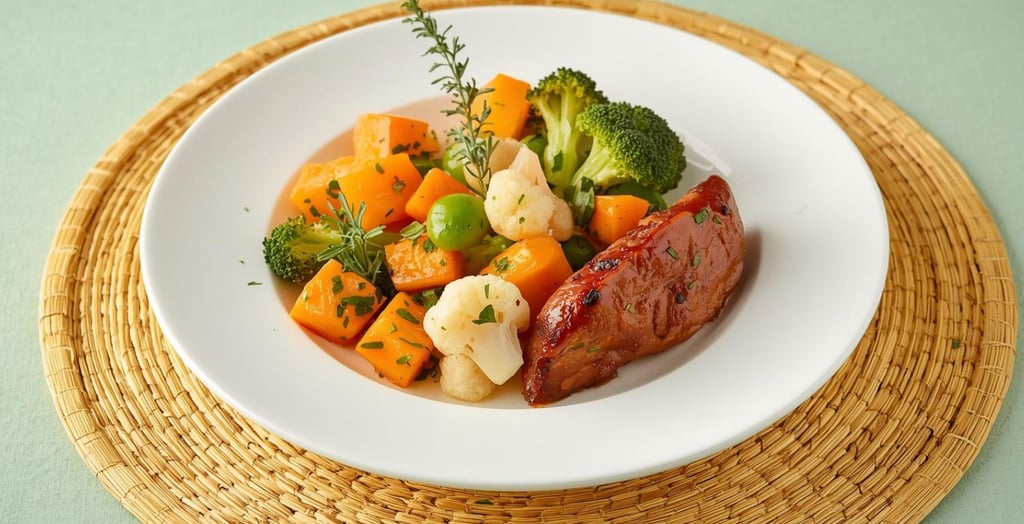Recipe: Mixed Vegetables with Butternut Squash – Wholesome & Flavourful
There’s something deeply comforting about a well-prepared vegetable dish-especially when it’s bursting with colour, texture, and seasonal goodness. “Mixed Vegetables with Butternut Squash” (Mixed Vegetables with Butternut Squash) is more than just a side dish; it’s a celebration of autumn’s harvest, a harmonious blend of earthy sweetness and crisp freshness that nourishes both body and soul. Designed to serve four people, this dish brings together humble ingredients - onion, garlic, butternut squash, cauliflower, broccoli, and Brussels sprouts and transforms them through gentle cooking and thoughtful seasoning into something truly special. Let’s explore this recipe in detail, from ingredient selection to step-by-step preparation, along with tips for customization, serving suggestions, and the nutritional benefits that make this dish a standout on any table.
10/11/20254 min read


Ingredients (Serves 4)
3 tablespoons olive oil – Extra virgin olive oil is preferred for its rich flavor and health benefits, though any neutral oil can be used if desired.
100 g onion – About one medium onion, finely chopped. Yellow or white onions work best for their balanced sweetness and pungency.
1 kg butternut squash – Peeled, seeded, and cut into 2–3 cm cubes. Butternut squash is ideal for its dense texture and natural sweetness, but other winter squashes like kabocha or acorn can be substituted.
150 g cauliflower – Cut into small florets. Fresh is best, but frozen can work in a pinch (just be sure to thaw and pat dry).
150 g broccoli – Also cut into bite-sized florets. Look for deep green, firm heads with tightly closed buds.
100 g Brussels sprouts – Trimmed and halved. These add a slightly nutty, cabbage-like note and a satisfying crunch.
2 teaspoons Vegeta – A savoury vegetable-based seasoning blend containing salt, dehydrated vegetables, and spices. If unavailable, substitute with a mix of sea salt, garlic powder, onion powder, celery seed, and a pinch of paprika.
2 garlic cloves – Finely minced or crushed. Garlic adds aromatic depth and pairs beautifully with roasted squash.
1 tablespoon chopped fresh parsley – Flat-leaf (Italian) parsley is recommended for its clean, fresh flavour.
1 teaspoon fresh aromatic herbs – This can include thyme, rosemary, sage, or a mix. Thyme is particularly complementary to squash and works wonderfully here.
Step-by-Step Preparation
1. Sauté the Onion
Heat the olive oil in a large, heavy-bottomed skillet or wide saucepan over medium heat. Add the finely chopped onion and sauté for 3–4 minutes, stirring occasionally, until it becomes translucent and just begins to soften. Avoid browning it too much, this step is about building a flavour base, not caramelizing.
2. Add the Butternut Squash
Peel the butternut squash, cut it in half lengthwise, scoop out the seeds, and dice the flesh into even cubes. Add these to the pan with the onions. Reduce the heat to low or medium-low and cook gently, stirring occasionally, for about 10–15 minutes. The goal is to soften the squash slightly and allow its natural sugars to caramelize at the edges without burning. A lid can be placed slightly ajar to help steam the squash gently if your kitchen runs hot or if the pan is drying out.
3. Blanch the Other Vegetables
While the squash is cooking, bring a pot of salted water to a boil. Prepare an ice bath (a bowl of cold water with ice) nearby. Add the cauliflower, broccoli, and halved Brussels sprouts to the boiling water and blanch for 2–3 minutes, just until they turn bright green and become tender-crisp. Immediately transfer them to the ice bath to stop the cooking process and preserve their vibrant colour and texture. Drain thoroughly and set aside. This quick blanch ensures the vegetables retain their structure and don’t become mushy when added to the squash.
4. Combine the Vegetables
Once the squash is tender but still holding its shape, gently fold in the blanched cauliflower, broccoli, and Brussels sprouts. You can stir carefully with a spatula or simply shake the pan to mix everything together. This minimizes breakage and keeps the dish visually appealing.
5. Season and Finish
In the last 1–2 minutes of cooking, add the Vegeta, minced garlic, and fresh aromatic herbs (like thyme). Stir gently to distribute the seasonings evenly. The residual heat will mellow the raw garlic and release the essential oils from the herbs. Finally, sprinkle with freshly chopped parsley just before serving to preserve its bright flavour and colour.
Why This Dish Works
The magic of this recipe lies in its layered textures and complementary flavours. The butternut squash provides a sweet, creamy foundation, while the cruciferous vegetables offer freshness, slight bitterness, and crunch. The brief blanching technique ensures that each vegetable maintains its integrity, preventing the dish from becoming soggy - a common pitfall in mixed vegetable preparations.
Moreover, the use of Vegeta - a staple in many Balkan pantries-adds a savoury, umami-rich backbone that enhances the natural flavours without overpowering them. Combined with garlic and fresh herbs, it creates a seasoning profile that feels both homey and sophisticated.
Customization & Variations
This recipe is wonderfully adaptable:
Add Protein: For a heartier meal, toss in chickpeas, white beans, grilled tofu, or shredded rotisserie chicken at the end.
Make it Creamy: Finish with a splash of coconut milk or a dollop of Greek yogurt for a richer texture.
Spice it Up: Add a pinch of red pepper flakes or smoked paprika for warmth and depth.
Go Roasted: Instead of sautéing, toss all vegetables (including squash) with olive oil, salt, and herbs, then roast at 200°C (400°F) for 25–30 minutes for a deeper, caramelized flavour.
Vegan & Gluten-Free: As written, the dish is naturally vegan and gluten-free just ensure your Vegeta brand doesn’t contain hidden additives if strict adherence is needed.
Serving Suggestions
This mixed vegetable dish shines as a versatile side. It pairs beautifully with:
Grilled or roasted meats (chicken, pork, lamb)
Baked fish or seafood
Grains like quinoa, farro, or brown rice for a complete vegetarian bowl
Crusty bread to soak up any flavourful oil left on the plate
It also reheats well, making it an excellent meal-prep option for lunches throughout the week.
Nutritional Benefits
Packed with fibre, vitamins, and antioxidants, this dish is a nutritional powerhouse:
Butternut squash is rich in beta-carotene (vitamin A), vitamin C, and potassium.
Broccoli and cauliflower provide vitamin K, folate, and cancer-fighting compounds like sulforaphane.
Brussels sprouts are high in fibre and vitamin C.
Olive oil contributes heart-healthy monounsaturated fats.
Garlic and herbs offer anti-inflammatory and immune-boosting properties.
Together, they create a meal that supports digestion, immunity, and overall wellness.
“Mixed Vegetables with Butternut Squash” is more than a recipe - it’s an invitation to slow down, savour seasonal produce, and enjoy food that feels both nourishing and satisfying.
This dish is both wholesome and satisfying, making it wonderfully versatile for any part of your meal. It can be enjoyed as a light starter, served as a nourishing main course especially for vegetarian or plant-based meals or paired as a flavourful side dish alongside roasted meats, hearty stews, goulashes, rich sauces, and more. Its natural sweetness and vibrant textures complement a wide range of savoury mains, while its nutritional richness ensures it never feels like an afterthought. Whether you're planning a cozy family dinner or an elegant gathering, this mixed vegetable medley with butternut squash adds colour, balance, and comfort to the plate.
Stay informed!
Subscribe to get the latest food safety tips!
© 2025. All rights reserved.
letstalk@lorybs.com
